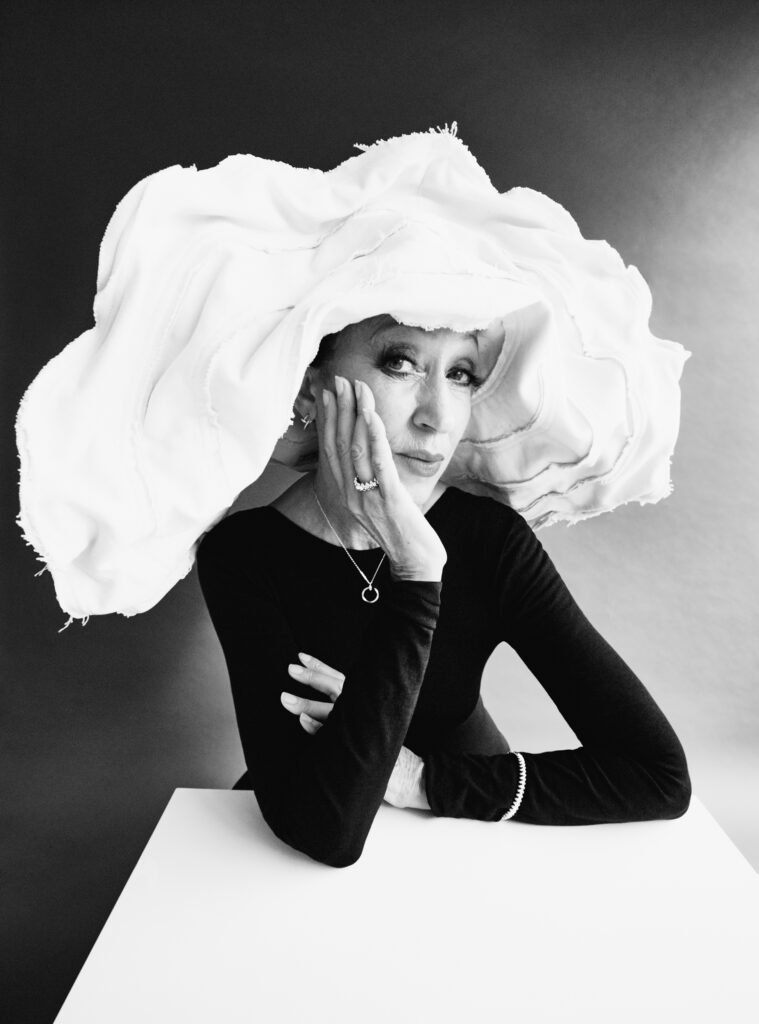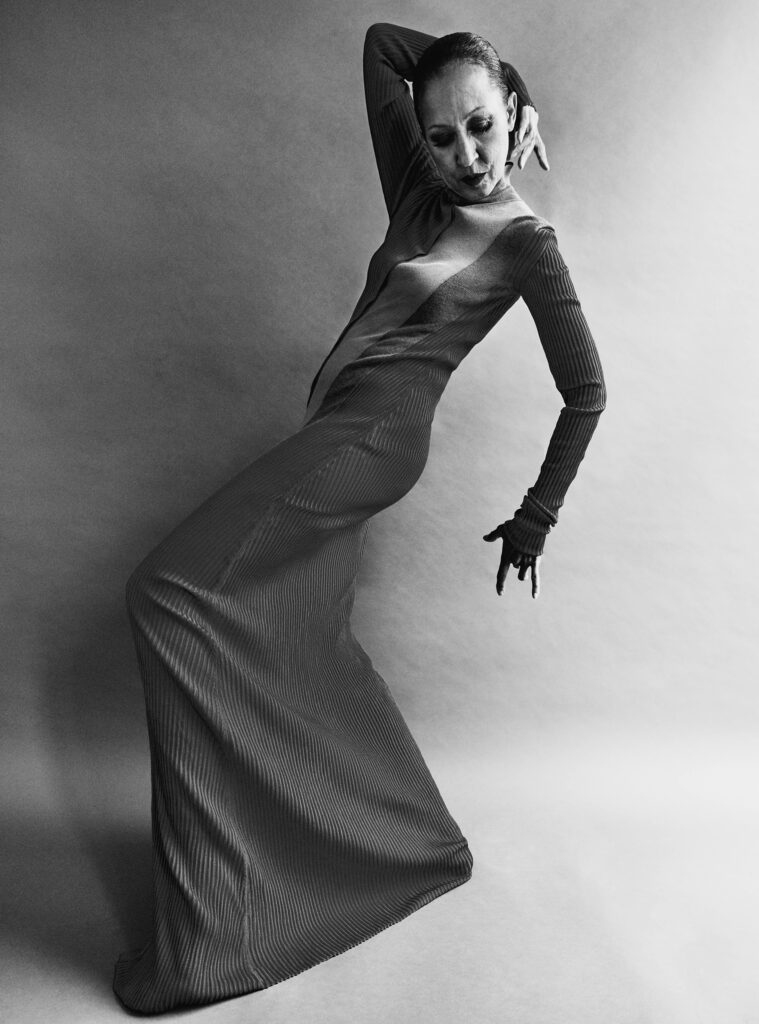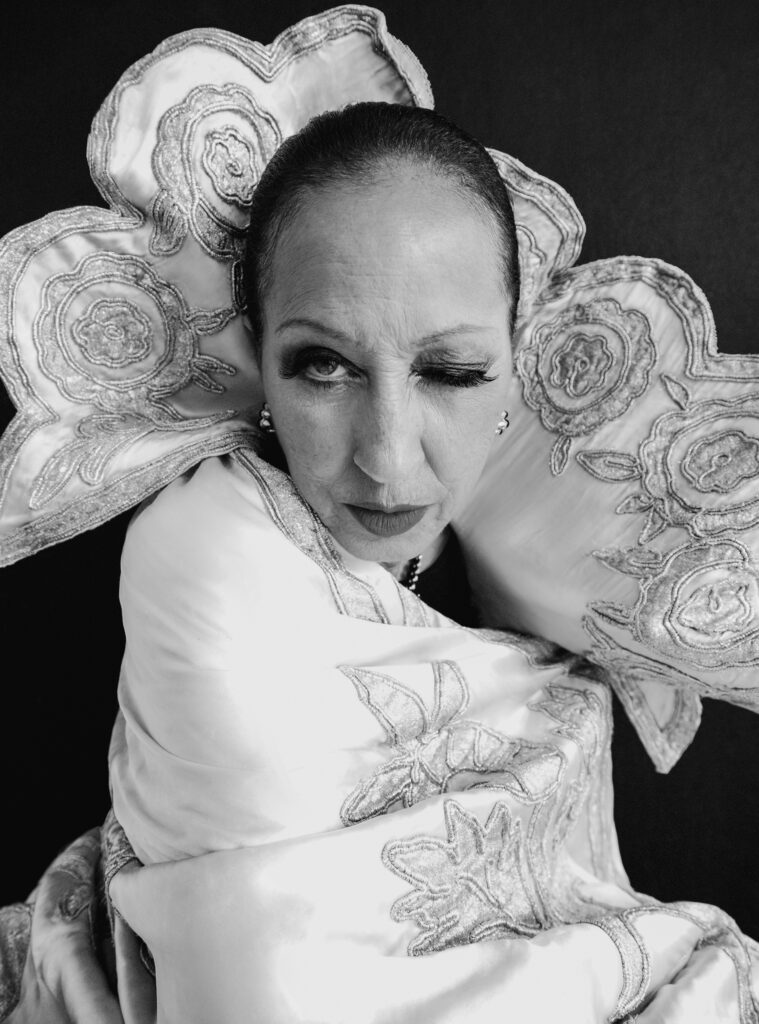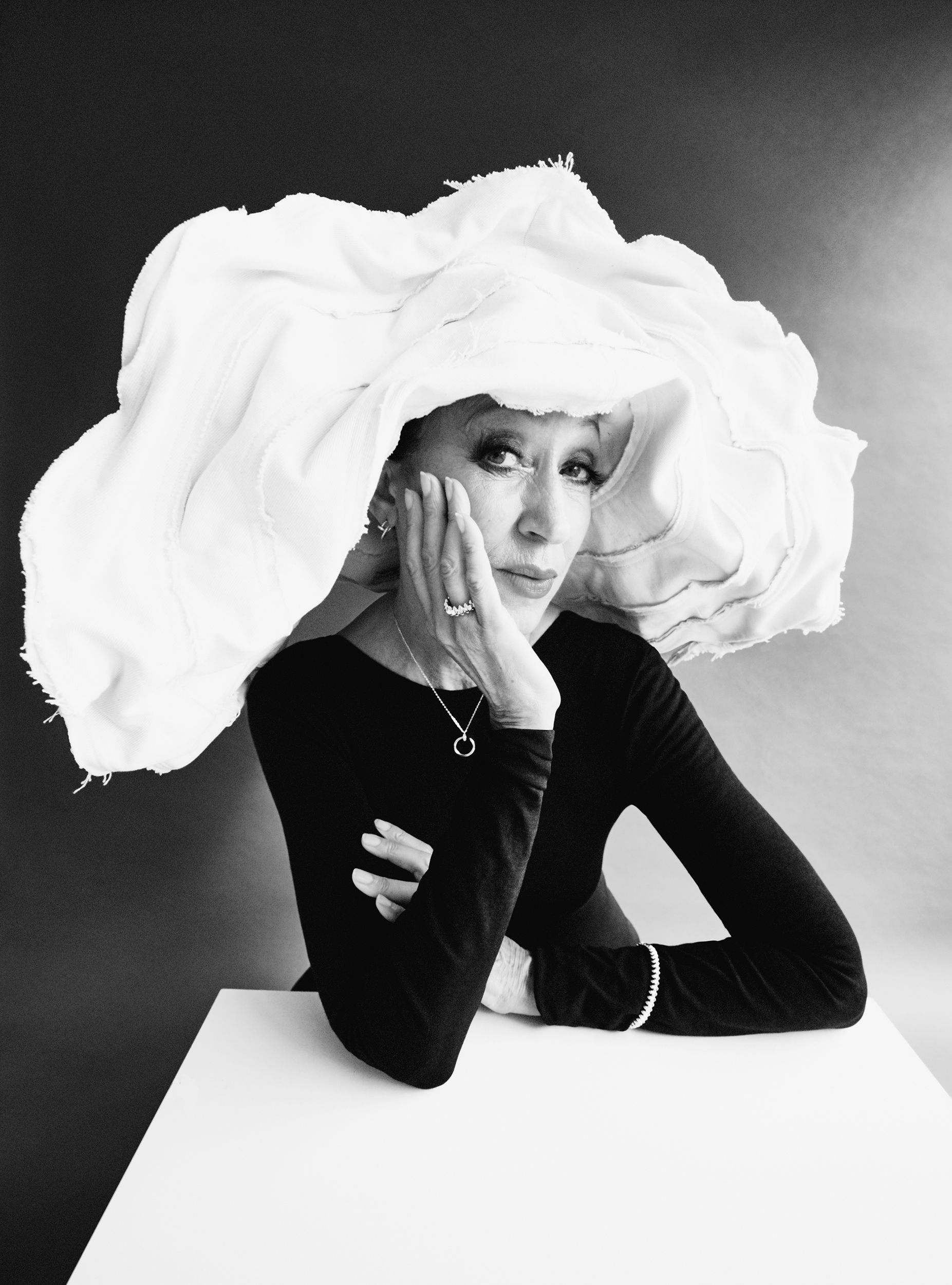André Leon Talley once dubbed her “the Josephine Baker of international runways.” Halston, many times, many moons ago, danced the night away with her at Studio 54. Diane von Furstenberg described her as “magical” to The New York Times in 2016. To the world, she’s known as a creative tour de force and one of the first Black supermodels.
To Anna Cleveland, she’s known as Mom.

A migrating monument in fashion history, Pat Cleveland was present at the industry’s most iconic and defining moments. Whether strutting down the Battle of Versailles or gracing the covers of fashion magazines worldwide, she’s seen the fads, the fame, and the frisson that went with fashion’s golden age. Unlike the trends that defined the decadent ’70s era, Cleveland cemented her staying power with a brazen spirit and a mentorship mentality. To say she’s taught a thing or two to model magnums (then in the making) Naomi Campbell and Tyra Banks would be an understatement. Mentor to the stars, confidant to fashion royalty, industry-defining icon—call her what you may. Cleveland’s imprint on the industry forever changed its path.
And the apple doesn’t fall far from the tree: Anna grew up behind the flash of the camera and beneath the pulsing lights of the runway. For her, it started with a debut at Moschino at five years old and continued with A-listers such as Chanel, Jean Paul Gaultier, and Zac Posen. With her chameleonic walk, Anna established herself as a consistent player in an industry with a revolving door that often spins at lightspeed.
Here, two generations of Cleveland women sit down for an intimate mother-daughter, model-to-model dialogue to discuss the desire for expression that defines their lineage, inspirations and all the grit, glitz, and glory that goes into a career spanning six decades.

PAT CLEVELAND: I’m approaching my sixth decade of modeling. It feels [incredible] to be able to say that.
ANNA CLEVELAND: It’s a huge accomplishment. How did you get into fashion? Growing up, I remember you telling me stories of how you and Grandma used to make your own clothes. That was kind of what sparked your interest?
PC: As the story goes for a lot of [creatives], when you’re born to an artist and you drink watercolor instead of Kool-Aid, you’re destined to follow in the [footsteps] of your parents. My mom was very creative and she painted as well, so, being in that [environment] allowed me to dream. The beauty of clothing and the art of [dressing] opened the door to fashion for me. Back then, wherever you were going, you would get dressed up. My mom used to wear these extraordinary satin dresses that she made. She’d throw fox furs over her satin dress and she’d go out in the evening. She’d wear lipstick, high heels, and stockings with a seam up the back of the leg. I was so fascinated, watching her get ready was almost like dressing a doll. That is something that has stuck with me my entire life.

AC: That makes sense because you got discovered as a model for your style and designs.
PC: First off, I have to say dressing up was not easy if you didn’t have a lot of pennies in the bank. But with the pennies that you do have, you invest in some kind of creative activity, for us it was making clothes. My mother and grandmother bought a bunch of fabrics and I made these little miniskirts when I was around 15. I wore them to school and one day there was a bus strike, so I had to take the train home with my friend. Oh my god, I thought I was being chased by a bad guy as I went across 42nd Street. My friend said, “There’s a lady following us,” but little did I know that the Vogue offices were nearby. This English lady stopped me and said, “Oh, dear. You’re dressed so beautifully. What are you wearing?” She ended up writing about me in Vogue. Before I knew it, I was at Carrie Donovan’s office with my design portfolio.
AC: And that debut in Vogue was your breakout moment?
PC: Well, sort of. I sent the Vogue [story] to Ms. Johnson of EBONY [Magazine]. She liked the images and asked me to come up to her office at the Waldorf Astoria’s presidential suite. I went with my portfolio thinking she wanted to see my designs but she wanted me to model in the EBONY fashion fair, which was the hottest ticket in town for Black society. I developed my [catwalk] strut walking on those homemade runways that were tables covered in carpet—where you could easily break your neck. We traveled across the U.S. in a greyhound bus putting on fashion shows for three months, with trunks of clothes in the belly of the bus and 10 other girls almost twice my age. I went back to school after that.

AC: Oh my goodness, that sounds like a [whirlwind]. As you entered the industry and got more into the world of modeling, what was that period of time like for models? Especially models of color?
PC: Well, color is not the problem, we were not the problem. The problem was the narrow-mindedness and prejudice of the industry at that time. I came into the modeling world in the ‘1960s and there were a lot of horrible things happening. You know, Kennedy got shot, and then Martin Luther King Jr.—who was seen as a Kennedy for our community—was also killed. There were racial layers to everything and being in magazines was almost impossible. That was why I admired someone like Donyale Luna and she had a really hard time breaking through. In my case it was also very difficult because there were not so many publications for girls of color at the time.
AC: So how did you [navigate] that?

PC: You had to put yourself out there and not give up. I remember one time, I snuck into [Richard] Avedon’s studio, I was so anxious obviously because I was not supposed to be there. I stood in the studio and I thought to myself “Oh, I would like to work with him.” And they threw me out almost immediately (Laughs). But then years later, Avedon loved me so much and I worked with him quite a bit over the years. I think a major [breakthrough] happened for me shortly after that. I was booked by Maning Obregon, an illustrator who worked with Carrie Donovan and Diana Vreeland. They needed a model to work with Vogue for the month when they were preparing their September issue. So I was lucky enough to land that and I started modeling for Diana Vreeland. Every day for like three months, I was with Diana in her office. Manning the illustrator and Diana, had to leave for Europe to do the collections. So I was sort of left there wondering who’s going to do the illustrations now up at Vogue. I was in the green room, and in walked this beautiful Puerto Rican illustrator named Antonio Lopez. That’s when my life changed. Really!
AC: Is that what caused the turning point for you to go to Europe?

PC: Yes, but something wonderful was happening before that and it was Stephen Burrows, who is still very important in American history as far as designers go. He used me as his muse. The minute I met him, I stopped designing clothes because I felt that he was designing exactly the way I would have wanted to. So I became his muse and he introduced me to Halston and Giorgio di Sant’ Angelo, he introduced me to everyone. Because of him, I was suddenly in this high society of fashion and attending these parties. And then I had my chance meeting with Antonio Lopez at Vogue. Antonio said, “You must come to work for me in Paris.” So I made my way over there, and I got myself a first-class ticket. I actually went to Italy first and found a [modeling] agency there and then I went to Paris. I met with Antonio and his career was really taking off at this point. Partially because there was an up-and-coming designer named Karl Lagerfeld and this designer Yves Saint Laurent who worked with Antonio. They were good friends. It was so funny because we had our own little tribe. And we had our own little game where I was bouncing back and forth between working with Yves and Karl, they put me on the map. We always had such a good time together. Paris was such a great experience and the reason people loved us so much there is because we were Americans, and we were pop art. We represented that new era of young people coming over to Europe to make a splash. And we did, we were the hottest thing. We tore Paris apart (Laughs).
AC: I mean you guys had several splashes like even the Battle of Versailles. What were some of your memorable moments of modeling?
PC: Yeah, well, my favorite memory is traveling the world. Traveling to Africa, Hong Kong, Paris, London Italy, and more. All of those things happened before ‘73. I was in places like this doing commercial work and television/film. And then suddenly I get this call from my team in America. They wanted me to come back to participate in this show that Liza Minnelli would be singing on. It was such a great opportunity but it wasn’t a high-paying job. It was about being part of this wonderful theatrical event where Liza would sing, and I would be one of the backup dancers. This opportunity was about being part of a group of girls from Seventh Avenue who had no hope in the world to ever be recognized. As for the Battle of Versailles, it was a meeting of the creative forces in fashion…all the designers in France and America. Funny enough, it was supposed to be just a party and they made a battle out of it. It was just a historical moment.

AC: You’ve had such amazing experiences with designers who helped you grow in the industry, but over the years you’ve used your success to help rising designers as well. Like, for example, Patrick Kelly.
PC: Well, I did that because there were so many talented younger designers and because of how [saturated] the fashion industry was at that time, a lot of them had no chance of being noticed. There was this young man who was introduced to me by a hairdresser that I liked very much. He said, “Oh, you know, I have this friend, and he’s really talented. But he’s working out of the closet in the house he’s staying in.” He then asked me if his friend could come over to my house. And I said, “Sure, he can come over.” But I was really sad at that moment because I was going through a breakup or something with one of my lovers. He rang the doorbell, and in walks a young Patrick Kelly dressed in blue jeans with a Southern accent. He smiled and said, “I have something for you.” He was holding a plastic bag and he pulled out a string of plastic bananas. And he said, “Would you wear this for me? I know you love Josephine Baker, and tonight, we’re gonna go out and do a show.” Somehow Patrick knew I loved to sing and I’d always sing Josephine Baker’s songs at The Mudd Club. He tells me to put on the bathing suit and stockings, paired with these accessories he made out of wire. The little bathing suit was made out of paper cups—like the ones you drink water out of. Once I was all dressed we threw a big salmon-colored cape over the look and walked down the block. At the time I lived near Central Park, it was a short walk to Columbus Circle where they were having a show. Before I knew it, I was in the spotlight, singing a Josephine Baker song in my little plastic bananas, and everyone loved it. It turned out Patrick had already seen a photograph of me in Vogue dressed as Josephine Baker, it was actually Horst [P. Horst] that photographed me as Josephine. The connection to Josephine, it was just one of those things, you know? My soul was connected to Josephine and her artistry and also my soul was connected to Patrick as well. As Patrick and I grew closer, I remember one time he said something sort of like, “I don’t know if I’ll ever make it to Paris.” I was leaving the next day to go back to Europe and I left him a ticket, a first-class ticket to Paris. I left the ticket with a handwritten note saying “You deserve this more than anyone in the world, let’s see what you’re going to do with it” and I didn’t sign it or anything. When you give somebody a chance, you just hope they’re going to use it wisely. Patrick did, he made a name for himself.

AC: You’re such a wonderful spirit. That generosity and grace light your spirit. You mentioned singing Josephine Baker, and we got a lovely treat last week. Jefferson [Hack] and I really loved your performance at our wedding. This is a nice [segue] into my last question—when is your album coming out?
PC: Well, I’m working on it now with Maurice Lynch, he’s an amazing writer and [theatrical] producer. He does Dancing with the Stars and the Oscars, and we have some new songs that are really fun to sing. I just sang at your wedding, which made me feel really good, because it was very beautiful to see everybody so in love. I felt so proud to be in that atmosphere with you and the gang. Now, I have a few things lined up for San Francisco and I’m going to be singing out there.
AC: You’re such a natural performer. I feel that you were born to be a performer. The world is your stage, isn’t it?
PC: Well, Anna, you should know you’re my inspiration. I’m so inspired by you because you’re the new generation, and you’re just giving it to them.
This story appears in the pages of V144: now available for purchase!
Photography Nick Thompson
Fashion Oliver Volquardsen
Makeup Joey Choy (Premier Hair & Makeup) using LA PRAIRIE
Hair Paula McCash using BaByliss PRO & ORIBE
Manicure Chisato Yamamoto (Caren) using CHANEL Le Vernis
Production Alexandra Oley
Discover More









